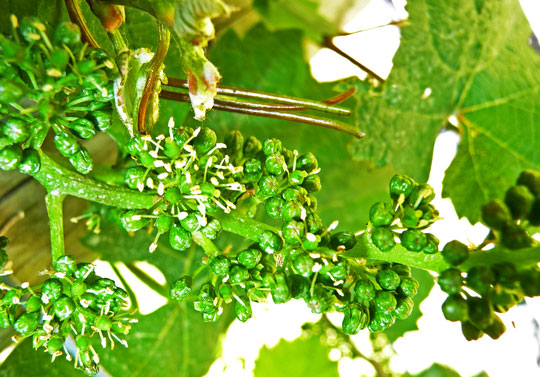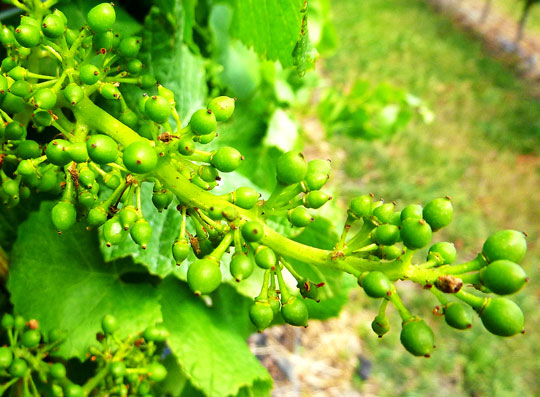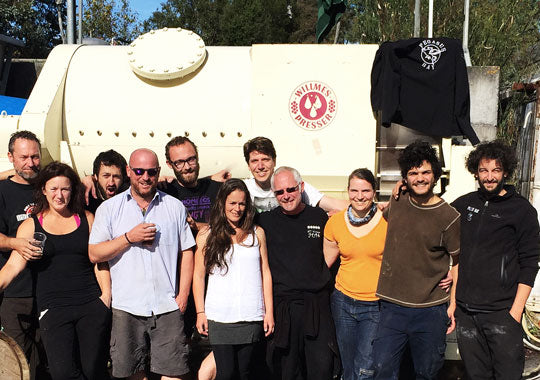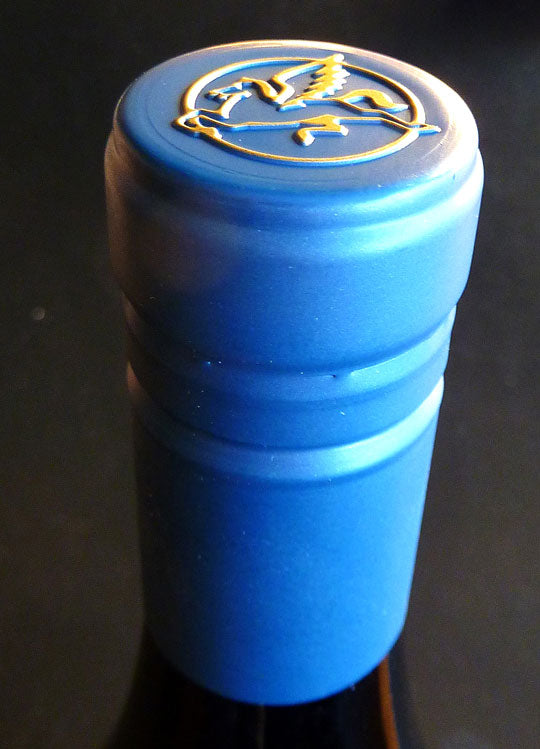Spring Sex in the Vineyard
Spring has almost sprung and is on our doorstep. Mother Nature is once again intent on renewing herself. In the vineyard it is an exciting but nervous time. The dormant buds swell and then slowly burst open, revealing their brilliantly green but tender little leaves and shoots. Should a spring frost occur, this growth may be destroyed with a loss of fruit the following autumn. But even if Jack Frost is thwarted and the vineyard is unscathed a miserably small crop may disappoint the vigneron when it comes to harvest time. Why is that?
It is partly because the maximum potential size of the crop is already decided. Yes, the number of inflorescences, which is what the little clusters of flowers are called, and even the number of flowers on these inflorescences, has been predetermined and lies secretly locked away inside the buds. If buds are dissected and examined under a microscope before they burst then these inflorescences and flowers can be counted. The exact count varies widely from one year to the next and the maximum potential size of any vintage is decided by this number, which in turn depends on the weather: not the weather this coming spring and summer but that during the previous season when the buds were being formed. That’s right, the maximum potential size of our 2016 vintage was decided during the 2015 spring and last summer. As these were very warm, the crop next vintage might be quite substantial. The converse applies if growing conditions are cool in the spring and summer, which helps explain why the harvest in 2015 was smaller than average.
But note, we have only been talking about potential. It’s a bit like counting your chickens before they have hatched and if you have done any cooking recently you may have been pleasantly unsurprised not to have one in your bowl after cracking your eggs. Should you have been shocked, it would have been the result of sex. Plants, like animals, indulge in this amusing little past time, even although it seems to be somewhat less frenetic in the leafy kingdom. A good number of plants play the passive role and just lie back, letting their insect minions bring them the goods; the male part, the pollen. Many plants could be regarded as incestuous but grapevines take things to the extreme and are happy fertilising themselves without the help of creepy-crawlies.
In our vineyard the vines indulge themselves in style during November and early December. If you walk through the vineyard on a warm evening you will be immediately struck by the redolent, heady perfume of them mating. The flowers may be small but they have power en masse. The aim is to get some of the pollen grains that are floating about in the air to land on the stigma, which is the swollen free end of the pistil or female sex organ. At its other end lies the ovary, which contains the ovules that will become seeds if they are fertilised. For fertilisation to occur each grain of pollen needs to grow a microscopic tube from the stigma down into the ovary and to fuse with an ovule. Although this seems a tiny distance to us it is enormous for the minute grain of pollen and easily exhausts its energy reserves. The process is highly temperature dependent but needs to occur within 10 hours or the pollen will die and the ovule will remain unfertilised. Cool weather will slow this mission, rain may wash the grains off or wind may blow them away. This is why grapes “set” best in warm, dry calm weather.

If none of the ovules in an ovary are fertilised then the potential berry would have no seeds and thus be useless in the process of reproduction. Mother Nature has fooled animals into thinking that sex is all about pleasure but behind this aura of kindness and love she is ruthlessly hardhearted and has no time for those that do not do her bidding. Her grapevine will not waste its energy on enlarging function-less berries and any that are not fertilised remain tiny or fall off the bunch; they do not “set”. Thus, the set or number of normal sized berries in a bunch is very dependent on the weather over flowering. Prolonged bad weather will result in a miserable grape grower while the converse also applies. But vignerons are like farmers and seldom seem happy with the weather. Splendid weather over flowering can produce bunches that are so jam-packed that there is no space between the berries, which makes them liable to fungal disease and mould. Hence, a few cool days scattered during the flowering period results in a perfect set with plenty of berries packed more loosely so that air can circulate between them. We are a fussy lot, aren’t we?

Vintage Birds 2015
Birds are like news, there are good and bad types. Whether we like it or not we always get the bad before the good. As the crop ripens and vintage nears they flock to our vineyard and feast on the fruit. Then the good birds arrive to save our grapes. It is like a corny western movie with the cavalry appearing just when all seems lost. The good birds are much bigger than the bad ones and they are generally rapacious carnivores. They descend from the sky but don’t harm the little fellows in the opposite team; they just save the day by rolling up their sleeves and getting to work.
Yes, our winery vintage workers come from near and far. Generally they are young winemakers who have lined up to come to Pegasus Bay to get further experience. But let’s not forget the vineyard crew. Without them the birds would have eaten everything and there wouldn’t be a harvest. And the best part is that most will of them are local and will remain with us to carry on their valuable work throughout the year. Three cheers for all our vintage workers! And how was the 2015 vintage at Pegasus Bay? Somewhat down in volume but right up there in quality!

A Right Royal Riesling
What does a Royal have to drink after a tough day? We can tell you. After a day of taking in the Christchurch sights and a workout in the gym Prince Harry and his entourage drank Pegasus Bay Bel Canto Dry Riesling with their meal at Harlequin Public House. Restaurateur Johnny Schwass tweeted that it was “A Royal Wine of Choice”. We like to think that he was advised by his grandma and gramps on his dad’s side who put their royal lips to Pegasus Bay Chardonnay on a previous visit.
Screw Caps – A Breath of Fresh Air?
For quite some time screw caps have been available that allow different amounts of penetration of air into wine bottles. Yes, we can buy screw caps that allow minimal, moderate and large ingress of air into bottles. In fact, these descriptors are not a true representation of the situation because the actual volumes of gas are all really tiny but they allow different and precisely calculated amounts of oxygen into the wine. The winemaker can now decide exactly which type of screw cap is best for the wine. One of the criticisms which the cork industry has levelled against screw caps is that the latter do not allow the wine to “breathe” like cork. Cork is the bark of a tree and has a grain in it; just like the wood it has developed from. Over the months and years the tiny little tubules that are part of this grain in cork allow minute amounts of air to pass into and out of the bottle. Unfortunately, the grain varies from cork to cork and hence the rate and total amount of air that enters can vary from bottle to bottle. With time this leads to what is called “random oxidation”.
Some bottles will taste quite different from others, even although they were identical at bottling and carefully aged in the same cellar. Too much air has entered these and the wine has become “oxidised”.
If this occurs in a minor way the wine may just appear a little flat and dull. This process is quite independent of and different from “corking”, which is a musty taste due to mould that has grown on the bark before it has been processed into corks.
But it is generally recognised that the best corks for ageing wine are those with the tightest grain that allow the least oxygen ingress and a group of research workers at the University of Bordeaux has shown that the normal maturation of wine in the bottle does not require the presence of oxygen.
All of the processes of normal ageing can occur in wine that is hermetically sealed, although they do not happen as quickly. This means that such wine will age more slowly and gracefully and be in better condition after careful cellaring. Thus, while the humble screw cap is generally a superior seal and better for ageing wine than cork, the winemaker now has a choice of how rapidly or slowly the wine will age. If a wine is intended for early drinking it might be appropriate to choose a screw cap that will allow more oxygen to enter. This could apply to rough young reds that are made for consumption within the first year or two of bottling. Allowing them to “breathe” may hasten their ageing and make them mellow before their time. But they are spending their lives in the fast track, which, as we all know, seldom leads to a happy long-term outcome. Having been around since the days of ancient Greece, Pegasus could be said to be in it for the long haul and that is the way it likes its wines. We will keep the tightest of reins on its breathing so the old nag can be put down with confidence.

And the Winner is...
New Zealand’s hospitality elite met at Auckland’s St Matthews Church on Monday June 8th, anxiously awaiting the results of the 2015 Cuisine Magazine NZ Good Food Awards. Pegasus Bay was ecstatic to be back in the winners circle again, when it was named top of its category - NZ Best Winery Restaurant and awarded a coveted Chefs Hat. As New Zealand’s only national hospitality rating system the Cuisine Magazine Good Food Awards have quickly become the benchmark for the industry.
When first launched in 2005, Pegasus Bay received one of only two awards given at the time, that of NZ’s Best Casual Dining Restaurant. The Winery Restaurant category was established the following year, and since then Pegasus Bay have continued to dominate winning the category an unprecedented 6 times. New Zealand has just 37 ‘Hatted’ restaurants throughout country. The ‘Hat’ system is based on that used in Australia and comparable to the European Michelin star system. The Canterbury region as a whole excelled in the awards, with Roots Restaurant in Lyttelton awarded NZ Restaurant of the Year Supreme Winner and Christchurch restaurants Harlequin House, Saggio di vino and Pescatore all being awarded a Chefs Hat.
Pegasus Bay was also recently awarded Best Local Cuisine Book in New Zealand at the 2014 Gourmand World Cookbook Awards. The Vintners Table, published by Random House features 65 of the Donaldson family’s favourite recipes from five of their celebrated chefs, who have run the Pegasus Bay kitchen over the years. The Vintners Table includes the history of Pegasus Bay, the wines, vineyard, winery, family and region.

From the Prescription Pad
The media seems to be full of tales of abuse these days. They range from minor verbal altercations to the most aggressive and horrific physical and psychological attacks imaginable, with all points of the deviant and antisocial compasses visited in between these extremes. The term abuse is very general and really means to misuse something, especially in a bad or harmful way. It can be used with reference to the inanimate or animate and it is sometimes difficult to distinguish between the abuser and the abused. In other words, the word “abuse” often seems to be abused. For example, take the case of “alcohol abuse”, a subject much loved by the media. You will doubtless have known people who have abused themselves by drinking excessively and should you have woken the morning after the night before with a dry tongue and a muzzy head then you have joined the club. But did you abuse alcohol? You used it for its intended purpose; you drank it; admittedly to excess, but was that really abuse? As you are wine lover you almost certainly enjoyed it with food and it is likely that you also over-ate. Were you guilty of food abuse? Perhaps you jog and will eventually wear out your hips. Perhaps you are abusing exercise but I think that most of us would feel that you are abusing yourself. While it has become convention that overuse is a form of abuse I would suggest to you that the use of something for its intended purpose has to be grossly excessive to warrant using that term. But using something for a purpose other than that for which it was made is surely misuse or abuse.
I personally don’t know anybody who abuses himself or herself by drinking alcohol but unfortunately there are such desperate people. Most of us drink alcohol-containing beverages and there is plenty of evidence in the medical literature that these are not all created equal. In particular, studies in Europe and the United States have shown that beer and spirits are the preferred weapons of those who abuse themselves. It is not that wine cannot have the same effect if used to excess but simply that it is the least likely alcoholic beverage to be used in this way. From other investigations we also know that wine lovers form a different subset of the population from those who prefer other tipples and the former are generally more health conscious and responsible.
But, I’m sad to say, there is now irrefutable evidence that there is the occasional nutter out there who abuses wine by using it for some nefarious purpose other than drinking. I’m not just referring to the pampered wastrels who destroy good bottles of champagne by hurling them at the bows of ships or those who put it in their cooking. No, I am talking about a respected Aussie politician who has taken alcohol abuse to a new low level. Yes, the press recently reported that Peter Dowling, a member of Queensland’s ruling Conservative Liberal National party, was stepping down as ethics committee chairman and from the parliamentary crime and misconduct committee until an investigation into his actions was complete. His misdemeanours were said to include sending a text message from his mobile phone to his mistress, showing “a picture of his penis in a glass of red wine, a self-shot image of his crotch while wearing boxer shorts and a full frontal picture of his genitalia.” The Right not so Honourable Mr Dowling, who is a new-age, church-going husband with two kids, clearly had an ultramodern view on ethics and misconduct. A judgemental and ultraconservative senior government official insulted poor Peter’s intelligence by saying “Taking a picture of your penis in a glass of red wine isn’t the smartest thing you could do with it and I won’t be accepting any invitation from him in future to go for a drink.” I suspect, however, that there may be another side to this story. Louis Pasteur, the Frenchman who discovered microorganisms, once said that “Wine is the most healthful and hygienic of beverages,” and I wonder if Peter was just taking advantage of the sterilising properties of alcohol to give the old fellow a bit of a cleanout. Perhaps the text was merely meant to show his mistress what a good clean living fellow he was and that she didn’t need to have any concern about infections. Seen in that light you may be in a quandary as to whether he really is as dick-headed as he first seems. I will leave it to you to judge. At any rate, the anonymous senior government official needn’t feel so neurotic about having a drink with his old mate as any of Peter’s personal nasties should have been killed off by their unexpected dunking.
Being a wine lover means that you are unlikely to be abusive to or misuse your wine. You’re probably more likely to pamper it; making certain that is stored quietly in the dark, at a cool temperature and free from vibrations and the other vicissitudes of a wine bottle’s life. You are unlikely, however, to be as attentive to the needs of your bottles as Michel-Jack Chasseuil. This 73-year-old retired aeronautical engineer started combing auction rooms for the rare and precious well before collecting such foibles was fashionable. He usually picked them up at sales of valuable French art and furniture, where no one seemed to be interested in the contents of the deceased owner’s wine cellar. In this way Mickey has built up a modest little collection of 40,000 bottles, which he nurses in a secret cellar in western France; rather like a dragon guarding its hoard of gold, I imagine. It is said to be worth €50 million but this may be an under estimate for tax purposes. Now, although Mickey does drink a bottle or two every now and again he is clearly a gentihomme with a lot of self restraint and doubtless he would have passed the marshmallow test with flying colours.
Just in case your memory is a little fuzzy, let me remind you about the marshmallow test, which has become so well-known that it is virtually urban law. In the 1960s a professor of psychology, Walter Mischel tested a bunch of Californian school kids by giving them a marshmallow and telling them that they would get a second one after a quarter of an hour if they didn’t eat the first until the next arrived. He then left the room. A third of the kids earned their second treat, often through diverting their attention by covering their eyes, looking away, singing, kicking the table and other such cunning manoeuvres. Some even handled, smelt or licked the marshmallow, perhaps to test whether it was good enough to be worth waiting for the next one. The rest succumbed to the temptation of immediate reward. So what, you may say, some kids are more patient than others – what the heck? Well, the learned professor followed the subsequent careers of these children and found that those who earned their second treat got better exam marks, and went on to do better in life than the other two thirds who showed more psychosocial and attention deficit problems. The test has been repeated by a number of doubting psychologists, offering different rewards, but the results have been the same.
While Mickey, the wine nursemaid, would have undoubtedly come through the marshmallow test bathed in glory, I think that he might not have done so well on other psychological assessments. Perhaps his self restraint has been a little excessive and I wonder whether excessive toilet training has resulted in a retentive backlash because he is reported to live frugally, drive an old car and never take holidays. But then, perhaps he is afraid to be parted from his hoard for very long in case the rats break in. Although he “loves” his wine he seldom drinks it because this “world heritage” is a collection of bottled art, a “Louvre of wine”, and should be passed on to future generations. This noble man is placing his collection in the care of a foundation and in order to raise money for the organisation he is planning to hold a dinner for 10 lucky people at which he will open 8 of his precious bottles. The price is not yet determined because the places will be auctioned but knowing that the reserve is €10,000 per head should help you know where to pitch your first bid. Oh, by the way, you should factor in the price of a trip to Japan, because that’s where the dinner is going to be held. Mickey hasn’t made it clear whether this nosh up will include his 1735 Hunt’s Port or 1805 champagne that was once owned by Napoleon but doubtless you will feast with a Magnificent Seven, even should one of the 8 turned out to be corked. Statistics on that type of closure would suggest that it will be the case. A principal aim of this exercise is to stop his bottles being scooped up “by billionaires from Russia and Hong Kong who will drink it stupidly” and being a lover of fine wine I’m sure you would drink it intelligently.
But Mickey isn’t the only Frenchman who knows how to use a bottle of fine wine properly and show it the high life. Pegasus Bay, along with three other Kiwi wineries, Felton Road, Ata Rangi and Escarpment, have been invited to have their wines matched with special dinners in Michelin starred restaurants in Paris and Burgundy. My wife and I have drawn the short straw and are going to have to front up and talk about the flying horse. No doubt we will also be forced to eat some of that disgustingly unhealthy but decadently delicious French food. Now, if that is not abusing yourself then what is? Please spare a thought and shed a tear for us.

Recent Seasons
Drought conditions were staved off by a mid-summer downpour in 2008 but then beautiful weather followed. The growing conditions of the 2009 vintage were amongst our best and we were delighted with both the reds and whites. The 2010 season was marked by a cloudy and indifferent late spring and early summer. In February, however, the sun began to shine and we had 3 months of perfect weather, resulting in excellent ripeness and levels of natural acidity. The 2011 vintage followed a very warm season and was one of the earliest we have experienced, producing beautiful physiological ripeness. It was a complete contrast to the following season and 2012 was one of the slowest ripening vintages that we have seen. Dry weather in late autumn allowed a prolonged hang time, which has produced a splendid spectrum of flavours and a lively freshness. A mild spring, a warm summer and a long lingering autumn created a perfect prelude to the 2013 vintage. Autumn rain in 2014 caused us to pick earlier than usual but the early-season ripening of the grapes was precocious so that the harvested fruit was physiologically ripe. Later noble botrytis flavoured the aromatic whites.
